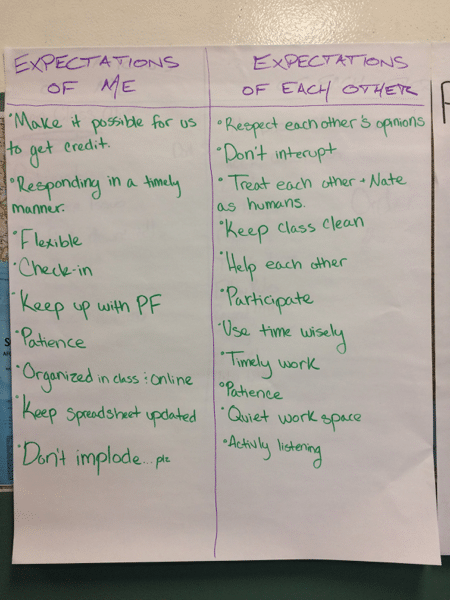Behavior Management Tools Might Not Be Best for Student-Centered Learning
CompetencyWorks Blog
 This post originally appeared at Students at the Center on September 14, 2017. It is the first in a series on the practical side of cultivating student ownership of learning, produced by JFF’s Student-Centered Learning Research Collaborative.
This post originally appeared at Students at the Center on September 14, 2017. It is the first in a series on the practical side of cultivating student ownership of learning, produced by JFF’s Student-Centered Learning Research Collaborative.
High-quality learning is often messy. It can be noisy and nonlinear and full of surprises. That may be why many of us seek to control it. We establish rules, plans, and procedures to contain the unpredictable outcomes of our students’ learning. And we distinguish behavior from academics as if the way learners are expected to accomplish their learning teaches them nothing about how to behave as learners.
The trouble is, many educators were taught to think about classroom management and behavior management as activities of control. Classroom management is seen as organizing and structuring the flow of activities and expectations to maximize efficiency and task accomplishment, while behavior management is framed as the teacher’s efforts to manage and respond to disruptions.
But what if control was the wrong impulse? What if our efforts to control behavior sometimes worked against our loftiest educational goals regarding college/career readiness, critical thinking, social-emotional health, and civic preparedness? What if there was another way to achieve our objectives besides control?
There is! With the explicit goal of fostering learner independence, student-centered learning calls for a different set of approaches, ones that are more akin to learner facilitation than learner control. Rather than prioritizing efficiency, order, and compliance, student-centered approaches draw from a wide variety of educational research (see the Students at the Center Research Portal) to create learning environments that inspire students’ academic, social-emotional, and metacognitive development. Recognizing that emotion is an integral component of all learning, facilitators of student-centered learning seek to personalize an optimal mix of risk-taking, disequilibrium, accomplishment, and confidence in each individual student. By intentionally modeling and coaching empathy, cultivating relationships with and among learners, and establishing a culture of partnership, trust, and support, learner facilitators move past merely controlling behaviors to cultivating motivations and inspiring engagement. And in the busy, messy, nonlinear world of high-quality student-centered learning, these approaches are used to drive the goal setting, self-regulation, and success that lead to social behaviors and mature thinking processes.
Here’s an example for one learner facilitator’s opening activities, well-timed for the beginning of the school year. After introductions, first-year teacher Nate Gray launches his classes by engaging students in collaboratively creating a T-Chart with the headings “Expectations of Me” and “Expectations of Each Other”:

When an individual student is disengaged or disruptive, Nate makes time to check in with the student privately, rather than control their behavior by singling them out in front of their peers. The conversation always begins with an invitation for the student to identify what they are having a hard time with, whether there are expectations they feel aren’t being met for them as well as by them, and what supports and/or strategies could help them be more successful. What’s important to note here is how Nate uses the chart not to control behavior, but instead to facilitate student inquiry, inspire greater social-emotional skill development, and to develop in his students the sort of self-directed and collaborative competencies prized by employers and colleges alike.
In both situations, collaborative problem identification is integrated with collaborative problem-solving. Building students’ capacity to identify and troubleshoot the obstacles to learning is an essential component of student-centered learning and it can be applied in classroom management as powerfully as it is in academic activity. Integral to this approach is the way educators and students understand, monitor, and manage motivation—the topic of the next post in this series.
See also:
- Red Flag: When Habits of Work and Learning Become Extrinsic Motivation
- Deadlines Matter: Debunking the Myth That Standards-Based Grading Means No Deadlines
- 6 Ways to Eliminate Attribution Error on the Path to Equity in Competency-Based Systems
Kim Carter is a Students at the Center Distinguished Fellow and Executive Director of the Q.E.D. Foundation, an organization of adults and youth working together to create and sustain student-centered learning communities.